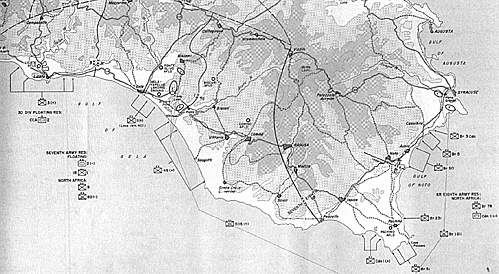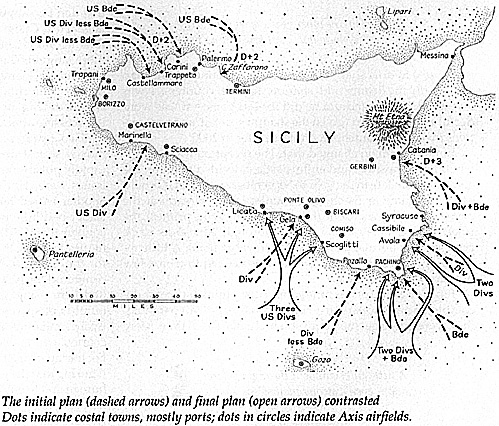Max Workman remarked that one reason he looked forward to Sicily: Triumph and Folly is his liking for invasion games. He has a good point, since a game that starts with an assault like this one offers numerous possible opening gambits. Scenario 5.4, the Complete Campaign, specifies the Allied units in the Floating Forces box but leaves the choices of where and when to hit the beaches, with what troops, up to the Allied player. This sort of flexibility gives the game inherent replayability, with room for plenty of fun experimentation.
That said, I'm the kind of guy who enjoys testing a game against the historical starting conditions. Written on the 57th anniversary of the landings, this article presents two Allied plans for Husky, the one originally developed by the Joint Planning Staff and the one actually used on 10 July. The original plan underwent several variations as the senior Allied leaders pointed out problems with it. The invasion plans shown here represent the "before Monty" and "after Monty" versions in their clearest forms.
Both these plans are in effect ways to play Scenario 5.4. Use the Axis setup, the in initial placement of Allied units, warships, and landing craft, start and end turns, and the victory conditions all as specified in scenario 5.4. You have plenty of sea and airlift capacity for the "dog's breakfast" plan, and just enough for the historical plan. In most cases, the hex locations mentioned here show the center of each assault area. You should land your forces on, near, and around these hexes (say within a two- or three-hex radius) at your discretion. When a range of hex locations appear, it shows the boundaries of the area where the specified unit landed. Where the invasion plan mentions all of a division, you should land all of its units, including the HQ.
The Three-Coast Plan
In January 1943, the Joint Planning Staff drafted a plan that called for landings in the southeast corner of Sicily, ranging from Gela around to Cassibile, on D-Day, to be followed by landings from Castellamare to Palermo (D+2) and Catania (D+3). Force 141, the Allied planning HQ, put forward this plan with little variation. When Montgomery raised objections, much contention ensued. Monty wrote that the Force 141 was "a dog's breakfast . . . it breaks every common-sense rule of practical fighting, and would have no chance of success . . . unless someone will face up to this problem and give a decision, there will be a first-class disaster." Game rule 3.6e, which activates the optional Naval Release Point at A13.17, gives you the opportunity to test Monty's evaluation. You should also add a new NRP at B30.30.
This invasion plan is not intended to produce a balanced competitive situation. The original plan did not name divisions specifically. While it does use British and America troops in their assigned sectors, following invasion schedule is arbitrary about which specific divisions are assigned to which wave. You can vary some assignments within nationality (for example, to have the Canadians land on D-Day instead of the Highlanders of 51st Division), but you should keep the nationalities, size, and locations of the invasion sites as shown here if you really want to taste the dog's breakfast.
To reproduce the staggered effect the planners intended, land the D-Day forces on the 10 July game turn, the D+2 forces on 12 July, and the D+3 forces on 14 July. As a variation, land both the D+2 and D+3 contingents on the 12 July turn.
The initial plans don't specify special forces or support unit assignments in any detail. By analogy with the actual assault plan and to give the Allies some more well-rounded assault forces, you may assign the following at your discretion to assault groups of the appropriate nationality and within your sea-lift capacity: 3 Cdo, 1 Rngr, 3, Rngr, 4 Rngr, 2 Chem, 3 Chem
The Historical Assault
To start off with the historical Allied landings, I suggest not using optional game rules 2.8, 3.6d, or 3.6e. All forces go in on D-Day.
The Initial Plan
Assault Location Units
British assault areas, D-Day
Avola, B48.30 5th Inf Div (all), 40 RTR
Pachino, B5631 50th Inf Div (69)
Pozallo, B55.26 50th Inf Div (151, 168, 2 Ches, 102 AT, Divarty)
Gela, B48.10 51st Inf Div (all)
Cosimo, B50.18 1.Abn Div (1-1, 2-1) by air drop
Ponte Olivo, B64.12 1.Abn Div (4-2, 5-2) by air drop
US assault areas, D-Day
Campobello, A40.08 1 Inf Div (all)
US assault areas, D+2
Castellammere, A25.10 45th Inf Div (157, 179, 753 Armored, Divarty,
120 Eng, organic trucks, HQ)
Trappeto, A23.13 2.Arm Div (1-66, 2-66, 3-66/2.Arm),
3d Inf Div (7, 15, Divarty, organic trucks, HQ)
Carini Bay, A19.15 45th Inf Div (180)
Cape Zaffarano, A20.23 3d Inf Div (30)
British assault areas, D+3
Catania, B31.26 1.Can Inf Div (all), 231 Bde
Gerbini, B32.22 1.Abn Div (31-, 62, 10-4, 11-4, 156-4, 1 Bdr, 2 Stf,
1 Pilot, Recce) by air drop and air landing

The Actual Landings
Assault Location Units
British assault areas
Cassibile, B46.31 5 Inf Div (all), 3 Cdo
Avola, B48.30 50 Inf Div (all)
Pachino, B53-31 to B55.30 231 Bde, 51 Inf Div (all), 1.Can Inf Div (all)
near Syracuse, B44.32 1.Abn Div (1 Bdr, 2 Stf, 1 Pilot) by air landing
near Syracuse, B43.32 1.Abn Div (Recce, 1 Arty, AT) by air landing
US assault areas
Scoglitti, B50.13 to B54.16 45th Inf Div (all)
Gela, B48.09 to B48.11 1st Inf Div (16, 26, HQ, 3-67 Arm, Divarty, organic trucks), 83 Chem, 1 Rngr, 4 Rngr
Licata, B49.03 to B48.04 3 Inf Div (all), 3 Chem, 3 Rngr
Piano Lupo, B47.13 82.Abn (1-505, 2-505, 3-505)

Back to Table of Contents -- Operations #38
Back to Operations List of Issues
Back to MagWeb Master List of Magazines
© Copyright 2000 by The Gamers.
This article appears in MagWeb (Magazine Web) on the Internet World Wide Web.
Other military history articles and gaming articles are available at http://www.magweb.com